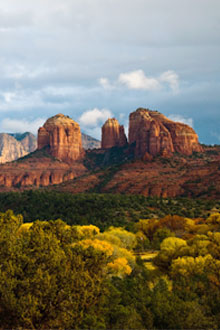Society for Tantric Studies Conference 2010
The Society for Tantric Studies met in September this year at the Little America Hotel in Flagstaff, Arizona.
Last week the Tsadra Scouts were sent to observe “academic Tantrikas” in their natural environment, The Society for Tantric Studies Conference. Composed of a relatively small group of scholars, the Society of Tantric Studies includes professors and independent scholars from several areas, mostly specialists in what we might calll “Hindu” Tantra and Buddhist Tantra. The attendees of the conference were quite diverse in terms of chosen topic, professional standing, and expertise. Although in previous years Tibetan studies was better represented, this year’s conference saw mostly Sanskrit specialists focused on Indology, Kaśmir Śaivism, Sāṃkhya, modern representations of Tantra, and comparative religions. The small numbers (perhaps 30 people) and the setting contributed to a comfortable and intimate feeling even though the topics people focused on were rather disparate. One presenter launched into a discussion of the concept of “core disgust” from a modern psychological perspective (very interesting in fact) while another discussed Satanism and modern Western esoteric traditions, and a third discussed early Śaivite divination manuals from a philological perspective. A master’s student gave a fascinating talk on the meaning and role of intellectuals using Seventeenth-century Sanskrit intellectuals as an example and established scholars David White and Gavin Flood both presented on the Netra-tantra. All of this variety contributed to a truly fascinating, if somewhat disjointed, academic conference. The variety also allowed us to observe the many behaviors and activities of academic Tantrikas in the wilds of Arizona.
One of the most fascinating presentations was on Abhinavagupta‘s ideas about aesthetics and it’s relationship to ethics. Professor Loriliai Biernacki proposed that through understanding Abhinavagupta we can see how ethics may be born out of the state of aesthetic wonder. She described the fascinating idea of rasa in Abhinavagupta’s aesthetics- an “undifferentiated dense mass of wonder.” The idea being, roughly, that through developing proper aesthetic sensibilities by connecting with this experience of wonder, ethical sensibility is also developed. Emphasizing the ethical element of aesthetic experience seemed a fascinating direction to me and the excellent discussion lit a fire of interest in Abhinavagupta’s ideas. I hope to read Dr. Biernacki’s paper as soon as it is available.
In “Erotic Forms of Ganeśa” professor Bühnemann showed surprising and fascinating images of the elephant-headed god in many different artistic contexts (Buddhist and Hindu sculpture and painting) in several countries (India, Nepal, Tibet, Korea, Japan). I had never seen nor heard that the Nyingma tradition had Thankas with Ganeśa in them, but the images themselves were even more interesting than that revelation. In one Thanka Ganeśa appears to be standing on the hands of a cat-woman who is either performing fellatio or drinking excretions from his linga while she menstruates into skull cups held by servants upon which she is standing. Apparently this tantric alchemical process allows for the practitioner to collect jewels from the skull cups, representing the attainment of the desired wealth, for which one would be propitiating Ganeśa in the first place.
“Netra-Tanra at the crossroads of the demonological cosmopolis.”
The keynote speaker, Professor David Gordon White, gave an engaging paper on the Netra-tantra spanning most of the evening on the opening day of the conference. The Netra-tantra is a text from Kashmir datable to the early 9th century CE. The Netra-tantra was referenced by Abhanavagupta several times and there is an extant detailed commentary on the text by his student Kshemaraja. The 19th and longest chapter is on demonology and this was the focus of Professor White’s talk. He stated that, “Like the Svacchanda Tantra and probably most tantras, the Netra is a composite work with at least two highly visible layers of redaction, the first of these is a demonological layer which comprises unadorned descriptions of demons, symptoms of demonological possession, and techniques for countering the same. This stratum of the text comprises a pragmatic technical guide to certain types of tantric ritual… the second layer of redaction which structures the text, for better or for worse, into a coherent and unified thesis is devoted to the deity Amritesha and more importantly to his all powerful conqueror of death mantra, which controls, routes, and slays demons with total accuracy…” Dr. White’s contention seems to be that the first layer is really the core of the text and that later layers, as well as commentarial traditions, manipulate the demonological data so as to further their own purposes. White’s analysis was of course considerably more complex than anything I’ll mention here but suffice it to say that demonology appears to have played an important role in the formation of tantric texts and tantra itself and that scholars will probably be spending more time on demonology in the future. To get a sense of how different Dr. White’s well-researched academic discussion of the Netra-tantra is, take a look at what is presented here: http://www.dhyansanjivani.org/tantra_mantra_yantra/the_netra_tantra.asp
The Academic Tantrikas’ Society for Tantric Studies
At a breakfast at an AAR in the late 1980s Glen Hayes, Charlie Orzeck and Jim Sanford decided to start a conference for Tantric studies. Alex Wayman was in attendance at the first conference held at the University of North Carolina retreat center. Since then the Society for Tantric Studies has steadily held conferences every three years or so, but due to the formation of a section at the AAR annual conference it appears they will meet less often. Hopefully, despite the small size of the conference, the next meeting will include more presentations from the Tibetan Buddhist perspective.
Before closing this little note on the conference and hopefully returning to blogging some of the very interesting papers at the IATS conference, I would like to note that the organizers of the conference, Glen Hayes and Paul Donnelly, were very friendly and open and I thank them heartily for their hospitality.


